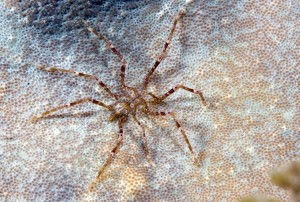Monster Monday: Sea Spiders
Monday, September 19th, 2016September 19, 2016
A sea spider is a terrifying beast. It has frighteningly long legs connected to a tiny body. It possesses no teeth or gaping jaws. Instead, it has a long tube called a proboscis, which it uses to suck the fluids out of its prey. Fortunately, sea spiders are too small to threaten humans. Furthermore, the largest ones live at the bottom of the ocean near the North and South poles, far away from people.
Sea spiders are ocean animals and most of them have eight legs. But they are not true spiders. Instead, sea spiders belong to a unique group of arthropods. Arthropods are animals with jointed legs and no backbones. Many sea spiders are slender and delicate. Others are chunky and robust. Most sea spiders are small, especially those found in shallow waters. They can be less than 1/10 inch (3 millimeters) across, including the legs. Sea spiders live in all the oceans, from the shallows to depths greater than 20,000 feet (6,000 meters).
Sea spiders feed by grabbing prey with their mouthparts. They then pierce the prey and suck out the fluids with their proboscis. Sea spiders feed on invertebrates (animals without backbones), especially those that are slow or fixed in place. Many sea spiders have colors and patterns that help them blend in with algae or other life on the ocean floor. Some are brightly colored, possibly to warn away predators (hunting animals).
The body of a sea spider is so small that there is little room available for its internal organs. As a result, some of the organs extend into the creature’s long limbs. Furthermore, sea spiders lack respiratory systems. Instead, the oxygen they need simply diffuses (flows) from the ocean water into their bodies.
Most sea spiders are quite small, but those near Antarctica and the North Pole can grow to more than 30 inches (75 centimeters) in diameter. In those areas, there are fewer critters that hunt sea spiders, and there are greater concentrations of what sea spiders like to eat. The frigid waters may also play a role in their giant proportions near the poles. Cold water holds more oxygen, so more of the gas can diffuse into a sea spider’s body, allowing it to grow larger.
Like most organisms, sea spiders are vulnerable to the effects of global warming, but the polar habitats of giant sea spiders increase their risk. As polar ice melts, giant sea spiders lose their protection from such predators as birds and marine mammals. Also, because warm water holds less dissolved oxygen, warming seas reduce the range of giant sea spiders. Scientists have identified more than 1,000 species (kinds) of sea spiders, but many more probably remain undiscovered. Because of the effects of global warming, scientists fear a large number of those unknown species will disappear before they can be identified.



